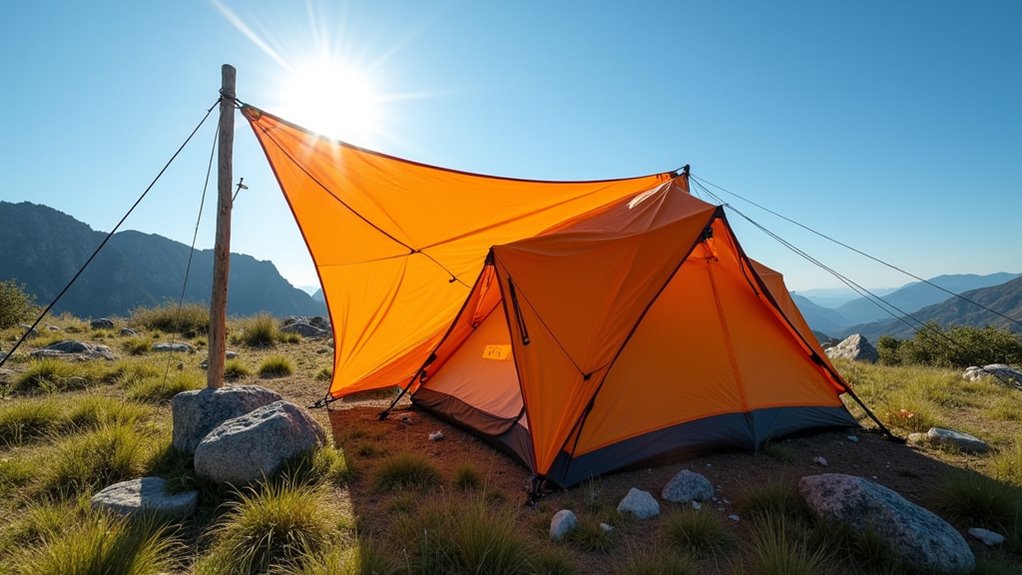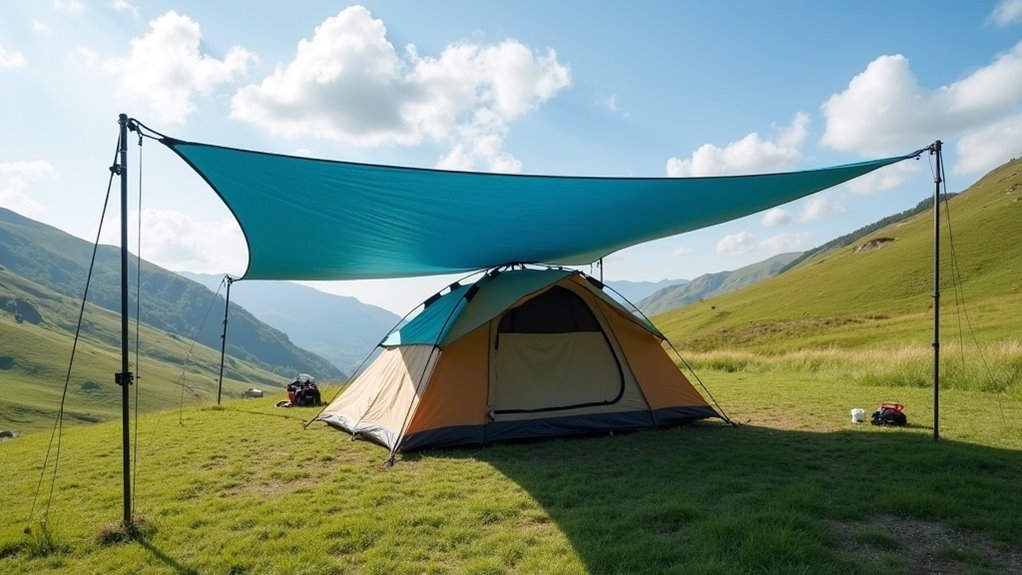How To Put A Tarp Over A Tent Without Trees
This post contains affiliate links. As an Amazon Associate, we earn from qualifying purchases.
To put a tarp over your tent without trees, use adjustable tent poles and heavy-duty stakes to secure and elevate the tarp. First, anchor the tarp corners to the ground with stakes, then use the poles to lift it, creating a peak that allows water to run off. Adjust guylines to keep the tarp taut and prevent sagging, and consider setting it up in a diamond or A-frame shape for extra stability. Further explanation and additional tips to enhance your setup will follow later in the article.
Essential Facts in 30 Seconds
- Use tent or trekking poles to create a tarp framework above the tent.
- Secure tarp corners to the ground with heavy-duty stakes.
- Tie and tension guylines to prevent tarp sagging and water pooling.
- Angle the tarp to direct rain away from the tent entrance and allow airflow.
- Check and tighten lines and stakes regularly, especially after bad weather.
Tools and Equipment Needed for Tarp Setup

Setting up a tarp over your tent makes camping better. It protects you from rain and sun. You need some tools and equipment to do it right.
Start with strong tent poles or light trekking poles. Poles with adjustable height help you keep the tarp tight and high. No poles? Use sturdy sticks or branches from the area.
Use strong, low-stretch cord like 550 Paracord for ridgelines and guylines. Make sure the cord is long enough to reach the ground. Use heavy-duty metal stakes that fit your soil type to hold the tarp edges.
Carabiners help attach the tarp quickly. Tarp clips add extra grip. Keep a measuring tape to place stakes in the right spot. Use a mallet to push stakes into the ground.
Adding a tarp not only protects against rain but also provides extra insulation from cold ground temperatures, enhancing your overall camping experience. A tarp also acts as a moisture barrier, ensuring that your tent stays dry even in wet conditions.
These tools make your tarp setup easy and strong.
Basic Setup Process Without Trees
Set up your tarp without trees by first securing the corners to the ground.
Use adjustable poles to hold up the tarp. Place poles at the corners or in the middle. This keeps the tarp stable and strong.
It also helps water run off and stops the tarp from blowing in the wind. A good setup keeps you dry and safe during rain or wind.
Secure Tarp Corners
Secure tarp corners to keep your shelter strong and steady. Start on flat ground without rocks or sticks. Push stakes or pegs firmly into the soil, about one foot away from each corner. Tent pegs are essential for anchoring your tarp securely.
Tie guylines tightly to the tarp’s grommets or loops. Use a taut-line hitch knot to adjust tension easily. Check the tarp often. Tighten the cords if the tarp loosens or flaps in the wind.
This simple setup stops tears and keeps rain out. Strong corners make your tarp last longer and protect better. Additionally, ensure stakes are driven securely, as driving stakes at a slight angle provides better grip and stability.
Erect Support Poles
Support poles keep a tarp steady and strong. Use poles made from aluminum or carbon fiber. They are light and tough. Steel poles work best in strong wind but are heavy.
| Pole Material | Height (feet) | Notes |
|---|---|---|
| Aluminum | 5 to 8 | Light and strong |
| Carbon Fiber | 5 to 8 | Tough and slightly bendable |
| Steel | 5 to 8 | Heavy, good for wind |
Place one pole in the middle to hold up the ridgeline. Put poles at the corners to pull the tarp tight. Push poles deep into the ground so they do not wobble. Use bungee cords or ropes to tighten the tarp. This stops rain or wind from getting under it.
Structural Configurations for Stability

Stable tarp setups need strong structures. These four methods boost tarp strength and resist wind well:
- Single Center Pole: Forms a pyramid shape. This shape fights wind very well.
- Dual A-Frame Poles: Balances the tarp and gives good headroom. It also holds ridgelines tight.
- Lean-To Design: Uses one pole and ground stakes. It makes a simple shelter with few supports.
- Adjustable Heights: Changing pole heights helps water flow off better. It also handles wind changes fast.
Strong setups keep you dry and safe during storms. Try these easy ways to build a tough tarp shelter.
Weather Considerations for Effective Shelter
Guarantee your tarp shelter works well by checking the weather first. Study the usual weather in your area. Set your tarp at an angle so rainwater slides off easily. Water pooling can make the shelter fall down. Make sure water drains away from where you live. Flat tarps can collect water and cause problems.
Face the tarp entrance away from the wind. This stops strong gusts and rain from blowing inside. Use thick tarps or stack them for better wind protection. Regularly inspect the tarp to check for sagging during rain. Tighten it to stop sagging.
On hot days, open vents for fresh air. On cold days, close the tarp tightly to keep heat inside. Additionally, consider waterproofing treatments to enhance your tarp’s effectiveness against rain. These tips make your shelter strong and cozy in all weather.
Anchoring and Guyline Techniques

Effective peg placement keeps your tarp stable. Use adjustable guylines tied with knots like the taut-line hitch. This knot lets you tighten or loosen the line easily.
Place multiple stakes at strong angles for better hold. These steps help your tarp stay secure in wind and rain. A well-anchored tarp protects you and your gear all night long.
Effective Peg Placement
Put pegs at a 45-degree angle away from the pull. This way, they hold better in the ground. Additionally, using proper peg angles ensures maximum stability and prevents potential issues during windy conditions.
Push pegs in diagonally at tarp corners or seams. This spreads the tension evenly across the tarp.
Keep guy lines long and flat on the ground. This helps the soil grip the line well. A well-secured tarp can significantly enhance your camping experience by providing effective protection from the elements.
Use pegs with notches or hooks. They stop lines from slipping when slack happens.
These simple steps keep your tarp tight and steady. Strong hold. Good shelter. Additionally, using sturdy stakes will enhance the durability of your setup in various weather conditions.
Adjustable Guyline Knots
Adjustable guyline knots help secure tarps tightly. They work well when you don’t have extra tools. The McCarthy hitch and Trucker’s hitch are popular choices.
Start by tying a bowline knot to make a strong loop on your tarp. Next, fasten the adjustable knot to a stake or tree. Pull the rope’s loose end to make the tarp tight. Guy ropes are crucial for ensuring the tarp remains stable in windy conditions.
The McCarthy hitch gives a 3:1 mechanical advantage, making it easier to tighten. Adding a slippery half hitch keeps the knot from slipping loose. Remember to position the ropes at a 45-degree angle for optimal support.
This method keeps your tarp firm and safe in any weather.
Enhanced Stability Techniques
A stable tarp setup needs strong anchoring and good guyline use. Use sand or snow stakes and deadman anchors. Bury them sideways for better hold in loose ground.
Tie tarps to tree roots or bush trunks with bowline knots. This adds extra strength. Attach many guylines to different stakes. This spreads out the pull and stops sagging.
Check and tighten guylines often. This keeps the tarp tight as the ground settles. These steps make your tarp hold firm in wind and bad weather. Even without trees, you can build a safe shelter this way.
Alternative Supports and Adaptations

Camping without trees? Use strong sticks or tent poles for support. Set two or more poles upright to make a ridge line. Use adjustable poles like MSR ones. Place shorter poles at the corners and taller ones in the middle for height.
Keep your tarp tight with paracord or rope. Tie knots such as taut-line hitches to hold tension. Add guy lines on sides to spread the pull and stop sagging. Push stakes or pegs deep into the ground to hold everything firm, especially if the wind blows hard.
Try common setups like A-frame or lean-to shelters. These shapes work well with many tarps and outdoor spots. Stay safe and dry with the right support and tension.
Frequently Asked Questions
How Do I Choose the Right Tarp Size for My Tent?
Match the tarp size to your tent’s footprint. Pick a tarp bigger than your tent. This extra size helps keep rain off and lets the tarp hang over the sides. Think about the weather and where you camp. Bigger tarps give better protection but weigh more. Smaller tarps pack light but cover less. Measure your tent’s length and width. Add at least one foot on each side for good coverage. This simple step keeps you dry and comfortable outdoors.
Can I Use a Tarp in Winter Conditions?
A tarp works well in winter camping. It blocks wind and snow. It helps keep warmth inside your shelter. You can set it up to allow fresh air to come in. This stops moisture and frost from building up. Using a tarp also gives extra space to cook or store gear. Many campers trust tarps for cold weather. They stay dry and warm under tarps. Simple, strong, and easy to carry. A tarp is a smart choice for winter outdoor fun.
What Are the Best Knots for Securing Guylines?
The bowline knot creates a strong, fixed loop for guylines. It holds well under tension and does not slip. The taut line hitch adjusts easily to keep the line tight. This knot slides to tighten or loosen as needed. Both knots keep tents steady in wind or rain. They work well with many rope types and sizes. Using these knots makes camping safer and more comfortable. Try practicing them before your next trip.
How Do I Prevent Water From Pooling on the Tarp?
Prevent water from pooling on the tarp by keeping it tight and sloped. Raise the corners higher than the middle to help water flow off. Make small holes or gaps for water to drain out. Check the tarp often for sagging and tighten it again if needed. A well-stretched tarp stops water from collecting and causing damage.
Is It Possible to Use a Tarp for Sun Protection?
A tarp made from UV-resistant materials like HDPE mesh blocks harmful sun rays. It helps stop sunburn while you enjoy outdoor activities. Using a tarp offers shade and lowers heat under it. Many campers use tarps to stay cool and safe in the sun. Pick a tarp that lets air flow but still shields your skin. This simple tool gives you comfort and good sun protection.
Conclusion
Setting up a tarp over your tent without trees is simple. Use stakes pushed firmly into the ground to hold the tarp edges. Poles or hiking sticks work well as supports. Tie the tarp to these poles to keep it steady. This setup protects you from rain and sun. Plan ahead to choose the right tarp size and materials. A good tarp keeps you dry and cool during camping. Practice this method before your trip for better results. This way, your outdoor adventure stays safe and comfortable.
